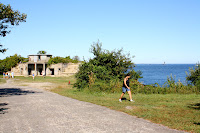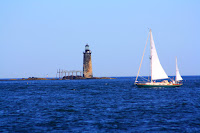Portland Head Light is a historic lighthouse in Cape Elizabeth, Maine that sits at the entrance of the shipping channel into Casco Bay. The headlight was the first built by the United States government, and is now a part of Fort Williams Park.
Construction began in 1787 at the directive of George Washington, and was completed on January 10, 1791. Whale oil lamps were originally used for illumination. In 1855, following formation of the Lighthouse Board, a fourth-order Fresnel lens was installed; that lens was replaced by a second-order Fresnel lens, which was replaced later by an aero beacon in 1958. That lens was updated with an DCB-224 aero beacon in 1991.
In 1787, while Maine was still part of the state of Massachusetts, George Washington engaged two masons from the town of Portland, Jonathan Bryant and John Nichols, and instructed them to take charge of the construction of a lighthouse on Portland Head. Washington reminded them that the early government was poor, and said that the materials used to build the lighthouse should be taken from the fields and shores, which could be handled nicely when hauled by oxen on a drag. The original plans called for the tower to be 58 feet tall. When the masons completed this task they climbed to the top of the tower and realized that it would not be visible beyond the headlands to the south, so it was raised approximately 20 feet.
The tower was built of rubblestone, and Washington gave the masons four years to build it. While it was under construction in 1789, the federal government was being formed and for a while it looked as though the lighthouse would not be finished. Following passage of their ninth law,the first congress made an appropriation and authorized the Secretary of the Treasury, Alexander Hamilton, to inform the mechanics that they could go on with the completion of the tower. The tower was completed during 1790 and first lit January 10, 1791.
During the American Civil War, raids on shipping in and out of Portland Harbor became commonplace, and because of the necessity for ships at sea to sight Portland Head Light as soon as possible, the tower was raised twenty feet. The current keepers' house was built in 1891. When Halfway Rock Light was built, Portland Head Light was considered less important and in 1883 the tower was shortened 20 feet and a weaker fourth-order Fresnel lens was added. The former height and second-order Fresnel lens was restored in 1885 following mariners' complaints.
The station has changed little except for the rebuilding of the whistle house in 1975 due to it being badly damaged in a storm. Today, Portland Head Light stands 80 feet above ground and 101 feet above water, its white conical tower being connected with a dwelling. The DCB 224 airport style aerobeacon is visible from 24 miles away. The 400 watt metal halide lamp is rated for 20,000 hours and produces 36,000 lumens of light at 200,000 candlepower. The grounds, and keeper's house are owned by the town of Cape Elizabeth, while the beacon, and fog signal are owned and maintained by the U.S. Coast Guard as a current aid to navigation. It was added to the National Register of Historic Places as Portland Head light (sic) on April 24, 1973, reference number 73000121.
 Fort Williams Park is a 90 acre park in Cape Elizabeth, Maine encompassing numerous historical sites. Perhaps most famous for having Portland Head Light on its grounds, the park also encompasses the decommissioned and largely demolished United States Army post Fort Williams, which was operational during World War I and World War II. This fortification became known as Fort Williams on April 13, 1899, by order of Army Headquarters (General Order No. 17, Headquarters of the Army, Adjutant General's Office, Washington, D.C.). It was named for Brevet Major General Seth Williams.
Fort Williams Park is a 90 acre park in Cape Elizabeth, Maine encompassing numerous historical sites. Perhaps most famous for having Portland Head Light on its grounds, the park also encompasses the decommissioned and largely demolished United States Army post Fort Williams, which was operational during World War I and World War II. This fortification became known as Fort Williams on April 13, 1899, by order of Army Headquarters (General Order No. 17, Headquarters of the Army, Adjutant General's Office, Washington, D.C.). It was named for Brevet Major General Seth Williams.As built, the fort contained three batteries, each with two guns, Battery Sullivan, Battery DeHart and Battery Hobart, all built between 1896 and 1898. Three other 2-gun batteries were added later: Battery Blair, 12-inch disappearing guns (1903); Battery Garesché, 6-inch disappearing guns (1906); and Battery Keyes, 3-inch rapid-firing guns (1906), the latter to guard a minefield. Searchlights were also mounted at various batteries.
 Between 1900 and 1911, most of Fort Williams' support buildings were constructed, including enlisted barracks, non-commissioned officers' quarters, commissioned officers' quarters (Officers' Row), hospital, gymnasium, post exchange, bakery, abattoir, commissary, laundry, chapel, fire station, Fort headquarters, and other buildings including garages and storage sheds. Infrastructure included an electrical substation, a bunkered telephone switchboard, and pumps and underground storage tanks for gasoline and fuel oil. Recreational facilities included a baseball diamond with concrete bleachers, and clubs (the officers' club utilized the already existing Goddard mansion, purchased by the government and added to the property).
Between 1900 and 1911, most of Fort Williams' support buildings were constructed, including enlisted barracks, non-commissioned officers' quarters, commissioned officers' quarters (Officers' Row), hospital, gymnasium, post exchange, bakery, abattoir, commissary, laundry, chapel, fire station, Fort headquarters, and other buildings including garages and storage sheds. Infrastructure included an electrical substation, a bunkered telephone switchboard, and pumps and underground storage tanks for gasoline and fuel oil. Recreational facilities included a baseball diamond with concrete bleachers, and clubs (the officers' club utilized the already existing Goddard mansion, purchased by the government and added to the property). During World War I, the fort was fully manned by artillery companies and National Guard troops. Anti-aircraft guns were added to the defenses during this time. Fort Williams served as the headquarters of the Harbor Defenses of Portland throughout World War II, during which time the last of the coastal artillery pieces were removed due to age and obsolescence. In January 1950, Fort Williams' mission was officially changed from a harbor defense post to a logistical and administrative support installation for all military units and personnel in the State of Maine.
During World War I, the fort was fully manned by artillery companies and National Guard troops. Anti-aircraft guns were added to the defenses during this time. Fort Williams served as the headquarters of the Harbor Defenses of Portland throughout World War II, during which time the last of the coastal artillery pieces were removed due to age and obsolescence. In January 1950, Fort Williams' mission was officially changed from a harbor defense post to a logistical and administrative support installation for all military units and personnel in the State of Maine.On Saturday, June 30, 1962, Fort Williams officially closed and was turned over to the General Services Administration to be sold. The property was sold to the Town of Cape Elizabeth on December 1, 1964. Many of the fort's buildings were gradually torn down, though several structures remain, either intact or as preserved ruins. Most of the concrete bunkers and gun emplacements were backfilled, though one (Battery Keyes) survives intact. One of the two emplacements of Battery Blair was recently unearthed again, with its surfaces cleaned and painted and interpretive signage added; plans are being made to restore Blair's second emplacement in like manner.
 Goddard Mansion, a prominent ruins inside of Fort Williams Park, was built in 1853-59 for Colonel John Goddard. It was purchased in 1898 by Judge Joseph W. Symond, and in 1900, during the expansion of Fort Williams (the army post), it was acquired by the federal government, which eventually converted it to quarters for noncommissioned officers. Currently, the mansion's remain ruins still stand on the hill overlooking Fort Williams.
Goddard Mansion, a prominent ruins inside of Fort Williams Park, was built in 1853-59 for Colonel John Goddard. It was purchased in 1898 by Judge Joseph W. Symond, and in 1900, during the expansion of Fort Williams (the army post), it was acquired by the federal government, which eventually converted it to quarters for noncommissioned officers. Currently, the mansion's remain ruins still stand on the hill overlooking Fort Williams.View Larger Map
Written history source: wikipedia.org
Photo's: ©Dave Peatfield 2012
To view the photo's on this page as a slideshow (Large Slide) click on any photo and they will open in a new window.








































































































